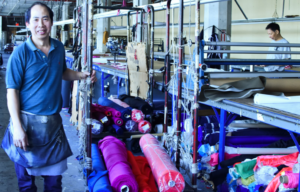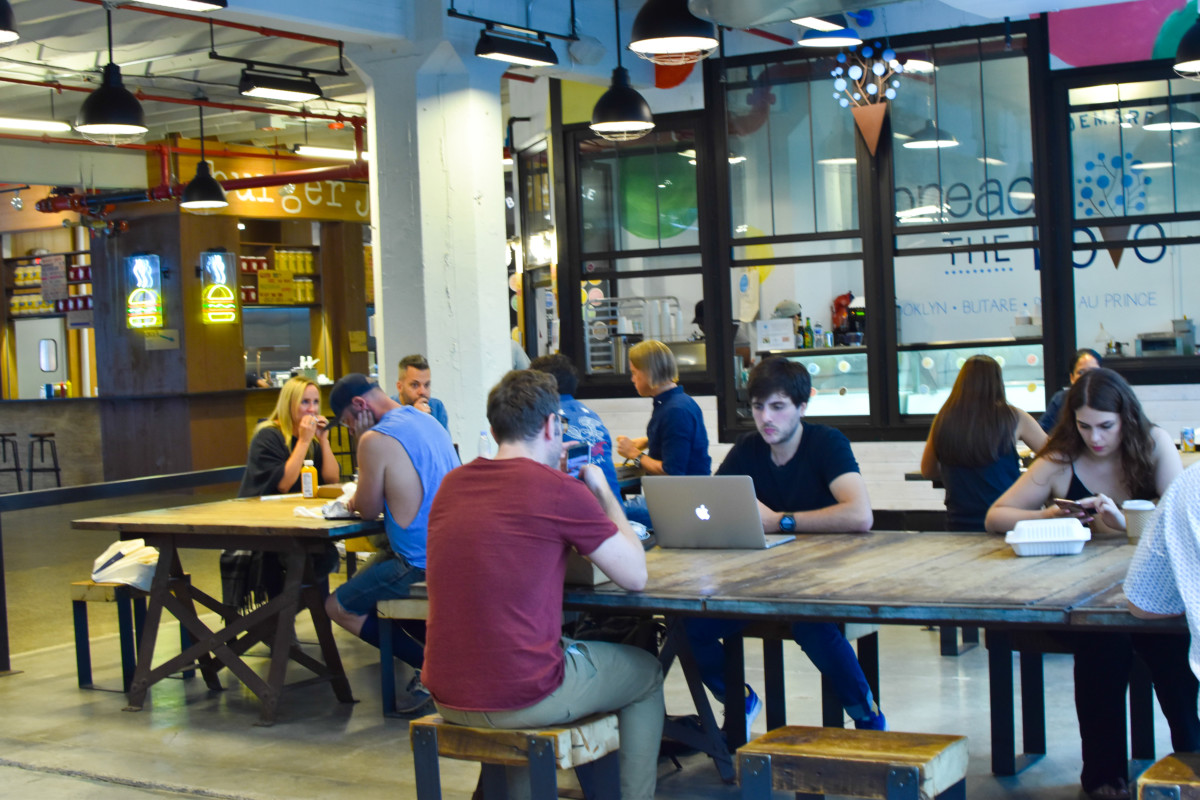With its whoopee pies and $18 cups of coffee, the 40,000-square-foot food hall will remind some visitors of Chelsea Market. In one corner is a stand boasting to be “the world’s first avocado bar,” selling smoothies, salads, and toasts. Down the hall, a “whole animal salumeria” makes sandwiches like pork pate and bacon with kimchi, cilantro, and red onion mayonnaise. At the taqueria, two small tacos and a bottle of water cost $9.12, which may seem high, but it’s just a few steps to long, communal oak tables or outdoor seating where there’s always plenty of room.
This food hall is not in Chelsea, however, but almost an hour away in Sunset Park. And every lunchtime it becomes the ersatz cafeteria for employees in Industry City, the 16-building converted industrial complex on the waterfront of this South Brooklyn neighborhood. If the dining hall feels out of place in Sunset Park, where the U.S. Census found 29 percent of residents live below the Federal poverty level, it’s because to some all of Industry City feels transplanted. According to Lisa Serbaniewicz, a spokesperson for Industry City, the current owners, who have poured $250 million into it during the past four years, are Jamestown Real Estate and Belvedere Capital–each prior backers of Chelsea Market.
And there’s a logic to this investment. The long-term wager is that the food hall here is going to get a lot busier. In February, Mayor Bill de Blasio announced the City is also putting $136 million behind a nearby “Made in NY” apparel campus scheduled to open in 2020. Plus, a rezoning plan for Manhattan’s Garment Center would have sent fashion companies and garment workers fleeing even sooner by removing rent protections.
Industry City’s arms have been wide open. “Fashion is an integral and growing piece of the creative and manufacturing greater picture at Industry City,” said Andrew Kimball, CEO of Industry City. Well-known brands like the Gap and Rag & Bone, along with eleven manufacturing companies, are already on its tenant roster.
But in an eventful week in mid-August, all these plans abruptly shifted. The Municipal Art Society, a nonprofit advocacy group, announced the results of a survey which found that 80 percent of garment workers and 65 percent of customers were unlikely to travel to Sunset Park. A few days later on August 18, 2017, the Garment Center Steering Committee, led by Manhattan Borough President Gale Brewer, held a press conference on the steps of City Hall to present their recommendations. With tape measures strung around their necks, politicians, fashion designers, and union representatives all drove home the point made by the survey: that Manhattan’s historic Garment District was under attack by the rezoning plan and that many jobs for women and immigrants would be lost. The press conference worked. Just hours later the City announced rezoning had been delayed indefinitely.
On an early autumn day in Sunset Park, however, the conclusions of that resounding survey did not seem to jibe with reality.
At the Industry City food hall, Jane Verderosa, Design Director at Alexis Bittar, was waiting for her lunch at the Burger Joint. In 2015, their Brooklyn-born eponymous founder, whose fall collection features a signature Lucite cuff bracelet for $245, had moved his company’s manufacturing functions from Dumbo to Industry City. This year in January, driven by ever-increasing rents, Verderosa and the rest of the company–design, marketing, production, and management–all joined them in Sunset Park. Some commuted from Queens, New Jersey, and Connecticut.
About the survey of Manhattan garment workers, Verderosa said, “Politics aside, I’m not surprised the majority reaction is an aversion to change. If you had asked me five years ago if I was interested in working in Sunset Park, I would have said no.” But now she describes herself as “pleasantly surprised. It feels like Dumbo did ten years ago.” She likes Industry City’s very creative atmosphere, its young workforce and fun things to do. She wore geometric chandelier earrings and an emerald jumpsuit, something she bought, as a matter of fact, at an Industry City-sponsored sample sale.

Jimmy Hwang is the owner of F&G Cutting, which cuts patterns for well-known contemporary fashion brands like Theory and Milly. Previously in the Garment District in Manhattan, he moved to Industry City ten years ago—again, because of the rent. Seventy percent of his workers lived in Brooklyn, but even those from Queens and the Bronx came with him. A soft-spoken man who likes to ask people “How’s business?” Jimmy is proud that his workers stuck with him through the relocation. “They were young guys. Now they are old.”
Moving to Sunset Park has been good for him and his 28 employees. At Industry City, Jimmy was able to rent 20,000 square feet for his cutting operations, double what he had had in Manhattan. This meant that his processes could become more efficient because of the space he had to stock fabric. Access to the loading dock is also much easier than in the Garment District, he said. Even though the price he pays per square foot now has doubled, he still believes it was the right move for him.
There are lots of stories like these. The By Boe jewelry company occupies one of the smaller spaces of 500 to 2000 square feet that Industry City calls “creative workshop spaces.” According to Jeremy Zisholtz, an associate in the leasing department, these spaces are 90 percent occupied.
By Boe has created a jewelry line “handmade in Brooklyn” that the trendsetting retailer Anthropologie describes as minimalist, modern, and feminine. The company itself sells online, as well as through Anthropologie and Amazon. By Boe is also carried by boutiques.
Founder Annika Inez, a tall blonde with stylish glasses who was born in Sweden, started her business in NoHo in 2004, then moved to Dumbo until “rents got sky high.” She brought her studio to Industry City three and a half years ago. “I live in Brooklyn, and I wanted a shorter bike ride,” she said with a laugh. Her six employees all came with her.
Annika admits being “swayed” by some of the activities offered by Industry City, such as luncheons for women in the fashion industry and a free business development course. She has hired interns from the local Sunset Park high school, an Industry City program she calls “fantastic.” She has also taken advantage of selling her jewelry in sample sales arranged by management. “Just personally, I love Sunset Yoga. For sure, it’s a management company here to make a profit, but we love the food hall and the events and concerts that have made it a destination.”
How soon will it become the destination for more workers in fashion and the garment trade? The forces of economic development will press on. But, as Alexis Bittar’s Jane Verderosa said, “If changes to the existing garment district prove to be inevitable, then Industry City is a great alternative.”


Leave a Reply